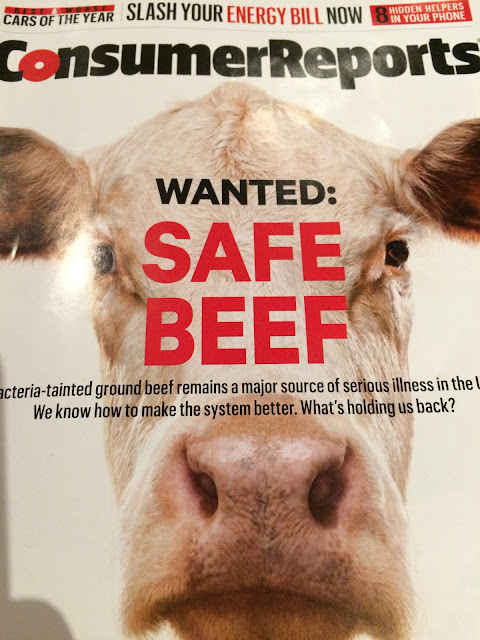 |
Cows destined to become steaks and hamburgers are confined to a feedlot and given antibiotics, hormones and other drugs to promote fast growth and prevent disease.
|
By VICTOR E. SASSON
EDITOR
Consumer Reports magazine has published a shocker on what conventionally raised cows eat, and how the beef from them is more likely to contain harmful bacteria.
"If you don't know how the ground beef you eat was raised, you may be putting yourself at higher risk of illness from dangerous bacteria," according to the editors of the expose, "How Safe Is Your Beef?"
"You okay with that?"
What they eat
In a side-by-side comparison called "A Tale of Two Cows," the magazine describes where conventional and grass-fed cattle live, their diets, drugs administered and how they are slaughtered.
The real eye-opener is the diet for conventional cattle, which are raised on pasture "for the first year or so" before they are confined to a feedlot.
"In the feedlot, corn and soy are the primary foods, but the cows may also be fed candy, chicken coop waste, and the slaughterhouse remains of pigs and chickens," the magazine reports.
"They may also be given plastic pellets, which are used as a substitute for the fiber they'd normally get from grazing on grass.
"Antibiotics, hormones and other drugs can be given to the cattle to promote growth and prevent disease.
"Large meat-processing plants slaughter as many as 400 head of cattle in an hour. Inhumane rapid processing may increase the chances of bacteria contaminating the beef."
 |
| The cover of the October 2015 issue of Consumer Reports, the nation's leading publication on food safety. |
Grass-fed advantage
When cows are grass fed, they "spend their entire lives grazing on grassland."
"Thus, these animals are not subjected to the crowded, disease promoting conditions of feedlots."
"Though grass-fed animals may be given antibiotics, their living conditions and diet generally make the need for them much less likely.
"Organic grass-fed cattle can't be given antibiotics or hormones," the magazine says.
"Grass-feed farms generally take their animals to smaller regional plants, where slaughter practices may be more humane."
How to cook ground beef
The magazine purchased 300 packages of ground beef from 103 grocery, big-box and natural food stores in 26 cities across the country -- both conventional and from cows raised in more sustainable ways.
"The results were sobering. All 458 pounds of beef we examined contained bacteria that signified fecal contamination, which can cause blood and urinary tract infections."
But "one of the most significant findings of our research is that beef from conventionally raised cows was more likely to have bacteria overall, as well as bacteria resistant to antibiotics, than beef from sustainably raised cows."
The magazine says if you are going to eat hamburgers and other ground beef, make sure you cook them "to at least medium," which is 160 degrees Farenheit.
"Eating a burger that's rarer can be risky."
No comments:
Post a Comment
Please try to stay on topic.